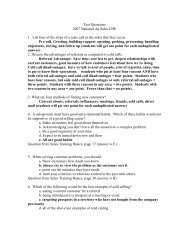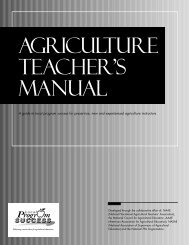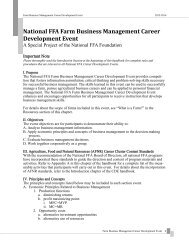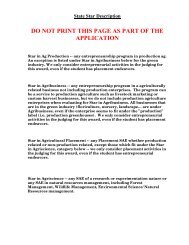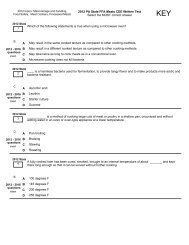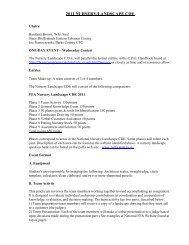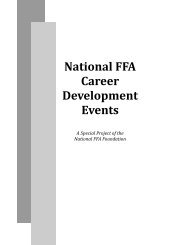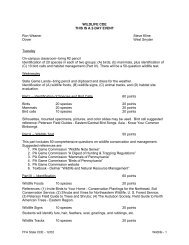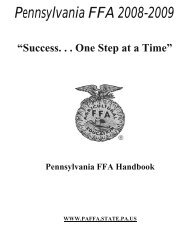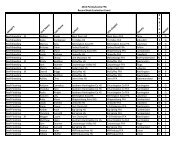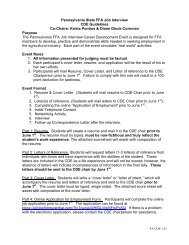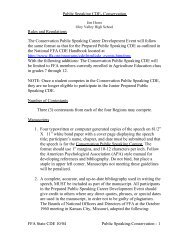Aquatics CDE Test Bank - Pa FFA
Aquatics CDE Test Bank - Pa FFA
Aquatics CDE Test Bank - Pa FFA
Create successful ePaper yourself
Turn your PDF publications into a flip-book with our unique Google optimized e-Paper software.
Aquatic Resource Contest Question <strong>Bank</strong>1. Wetlands comprise about ________ of Pennsylvania‟s lands.A. 5 percentB. .5 percentC. 8 percentD. 10 percent2. Which of the following characteristics are used to classify an area as a wetland?A. High water tableB. Wet or hydric soilsC. To be able to support aquatic plants or hydrophytesD. All the above are correct3. Which of the following is not an endangered species in Pennsylvania?A. Blanding‟s TurtleB. American BitternC. Northern Water snakeD. King Rail4. The term “endangered” meansA. The plant or animal is completely extinctB. The plant or animal is nearly extinctC. The plant or animal is protected by lawD. Both B and C are correct5. The term “threatened” meansA. The plant or animal is not under the immediate threat of extinctionB. The plant or animal is under the immediate threat of extinctionC. The plant or animal is very susceptible to diseaseD. None of the above are correct6. The term “indeterminate” meansA. That the species was extinct at one time, but now is notB. That a species maybe in dangerC. Information about the species is incompleteD. B and C are both correctE. A and C are both correct7. Which of the following factor(s) explain species disappearance?A. Too much inbreedingB. Adaptability and inbreedingC. Change is the only factorD. Adaptability and change
8. Phytoplankton is an example of which type of aquatic plant?A. EmergentB. SuspendedC. RiparianD. Submerged9. What group of pond plants are more of a problem in Pennsylvania ponds than anyother single group of plants?A. Submerged plantsB. EmergentC. FloatersD. Filamentous algae10. Rushes, sedges, and cattails belong to which group?A. Submerged plantsB. EmergentC. Filamentous algaeD. Floaters11. Algae may take the form of which of the following?A. Single-celled phytoplanktonB. Multi-celled filamentousC. Plant-like musk grassD. All of the above12. The maximum size of a pond‟s watershed should not exceed how many acres ofdrainage area for every acre of pond in farmland?A. 5B. 10C. 15D. 20E. 2513. Acid neutralizing capacity of a body of water is measured by a test called _____.A. AcidityB. NeutralizationC. AlkalinityD. Vulnerability
14. The Fish Commission has made the following stock pattern change(s) in someareas to combat the increased acidity in streams.A. Change from stocking acid sensitive rainbow trout to more acid tolerantbrook troutB. No pre-season stockingC. Discontinue stocking altogetherD. All the above15. Pennsylvania receives the most acid deposition of any state because:A. Pennsylvania is the third highest producer of the gases causing aciddepositionB. Pennsylvania is located downwind from the highest concentration of airpollution emittersC. Neither A or BD. Both A and B are reasons why Pennsylvania receives the most aciddeposition16. The most serious pollution problem in Pennsylvania comes from ______.A. AgricultureB. SewageC. Coal MiningD. Trash17. Which is not a general characteristic of snakes?A. Warm-blooded animalB. Considered a reptileC. Sensitive to temperature around themD. Unable to withstand extremes of hot or coldE. All the above answers are characteristics of snakes18. Which of the following is not a characteristic of the snake‟s tongue?A. FlexibleB. BluntC. ForkedD. None of the above are correct19. Which of the following venomous species is not found in Pennsylvania?A. CopperheadB. Massasauga RattlesnakeC. DiamondbackD. Timber Rattlesnake
20. Pennsylvanians use most of the groundwater pumped each day for _______.A. IndustryB. Water SupplyC. AgricultureD. Mining21. Shock chlorinating the water system means…A. <strong>Test</strong>ing the water system for the amount of chlorineB. Checking the amount of chlorine after a sudden rain stormC. Adding chlorine usually in the form of a household bleach to the watersystem and keeping it there overnightD. Nothing at all22. The converting of ammonium to nitrate is called ______.A. NitrificationB. TransportationC. HydrologicD. None of the above are correct23. The state‟s drinking water standard for nitrate nitrogen is ________.A. 2 mg/1B. 5 mg/1C. 7 mg/1D. 10 mg/124. To prevent nitrate contamination you should:A. Have a manure analysis to determine the amount of nutrients needed.B. Don‟t apply nutrients in the winter to frozen groundC. Avoid over applying manure on fields close to the barnD. All the above are preventive measures of nitrate contamination25. Which of the following is a way pesticides may be degraded?A. Chemical ReactionB. Ultraviolet LightC. Biochemical DegradationD. All the above are correct26. In the late 1980‟s the fish that has been researched and rehabilitated the most is________.A. Grass PickerelB. MuskellungeC. Yellow PerchD. American Shad
27. Walleye is referred to asA. The “Allegheny Fish”B. The “Delaware Killer”C. The “Susquehanna Salmon”D. The “Ohio Native”28. Pennsylvania‟s state fish is _______.A. Brown TroutB. Brook TroutC. Rainbow TroutD. Lake trout29. The largest (in length) Pennsylvania snake is the _______.A. Black RatB. Northern CopperheadC. Northern Black RacerD. Timber Rattlesnake30. It is unlawful…A. To deposit litterB. To fish in nursery watersC. To use artificial light to take frogs at nightD. All the above31. Which turtle is not endangered in PA?A. BogB. MudC. Red-belliedD. Wood32. Pennsylvania is one of the four states that contribute most to acid precipitation.What place are we holding?A. FirstB. SecondC. ThirdD. Fourth33. “Yellow boy” is a result of what type of water pollution?A. Radioactive wasteB. Petroleum productsC. SewageD. Coal mining
34. A groundwater contaminant commonly associated with agriculture is:A. BacteriaB. NitratesC. PesticidesD. All of the above35. Radioactive waste is a major water pollutant because it can:A. Cause “Yellow boy”B. Cause siltationC. Destroy tissues in living organismsD. Create excessive turbidity36. Pennsylvania mountain streams are very susceptible to acid rain because:A. Of the altitudeB. The buffering capacity of the bedrock and soils are poorC. The buffering capacity of the bedrock and soils are goodD. The water flows too slowly37. The „Massasauga‟ is listed as an endangered species of Pennsylvania because of:A. Forest SuccessionB. Tropical rainforest destructionC. Acid rainD. Overpopulation of predators38. The initials “PFD” represent:A. Pennsylvania Fish DepartmentB. Personal Flotation DeviceC. Pennsylvania Federation For DucksD. <strong>Pa</strong>n Fishing Delight39. You can identify a poisonous snake by its:A. NoseB. Mating callC. Vertical slitted eye pupilD. Double row of scales on tip of tail40. The largemouth bass belongs with what other fish in the same family?A. PerchB. WalleyeC. American shadD. Sunfish
41. The preferred water temperature that separates coldwater and warm water speciesis:A. 60 degreesB. 70 degreesC. 80 degreesD. None of the above42. The milk snake got its name for what reason?A. Its milky white appearanceB. it was thought to have milked cowsC. It spits out a milky white colored saliva when frightenedD. None of the above43. What powers the hydrologic cycle?A. HumansB. DamsC. SunlightD. Gravity44. Pesticide contamination of groundwater can be prevented by:A. Reading and following label directionsB. Making sure application equipment is in good working orderC. Avoid mixing pesticides near sources of waterD. All of the above45. Which aquatic insect is affected most severely by acid precipitation?A. MayflyB. Black FlyC. Water striderD. Mosquito46. Which group of fish is found at the top of the food chain?A. HerbaceousB. PredaciousC. InsectivorousD. None of the above47. Acid rain affects stream quality by:A. Raising the pHB. Lowering the pHC. Raising the temperatureD. Lowering the temperature
48. Water is used in nursery trout production must be rich in ______.A. NitrogenB. OxygenC. CalciumD. Carbon Dioxide49. Spawning behavior is a response to change in _______.A. FeedB. Water levelC. Day lengthD. None of the above50. An example of an amphibian that spends its immature life cycle on dry land andadult period in water is the ________.A. Red spotted newt (eft)B. Spotted salamanderC. Virginia toadD. Mud puppy51. Which of the following is a predator of trout?A. Giant water bugB. Water snakeC. KingfisherD. All of the above52. Which species of fish is not native to Pennsylvania?A. Brown troutB. Brook TroutC. Bullhead catfishD. Black nosed dace
53. Which is the largest predatory fish in Pennsylvania?A. Northern pikeB. PickerelC. MuskellungeD. American shad54. Which species listed below is considered a warm water fish?A. Black bassB. Brook troutC. Brown troutD. None of the above55. What structural difference is present in trout and catfish that is not present in mostother fish?A. Pectoral finB. Dorsal finC. Spiny barbs on ventral surfaceD. Adipose fin56. Catfish lack ______.A. FinsB. ScalesC. ReddsD. All of the above57. The bullhead is a member of the ______ family.A. CatfishB. BassC. SunfishD. Wallegap58. Optimum trout habitat would include _______.A. Slow moving warm waterB. Fast moving warm waterC. Fast moving cool waterA. Slow moving cool water59. Which of the following species is truly native to Pennsylvania?a. Brown troutb. Brook Troutc. <strong>Pa</strong>lomino Troutd. Rainbow trout
60. Which of the following are considered examples of wetlands?a. Bogsb. Rocky shoresc. Sloughsd. All of the above61. What is the cost of a fishing license without a trout / salmon stamp?a. $17.00b. $21.00c. $22.00d. $31.0062. Which of the following reduces the dissolved oxygen concentration of a pond?a. Organism decompositionb. Cloudy daysc. Nightd. All of the above63. Which of our venomous snakes do not possess rattles?a. Massasaugab. Copperheadc. Timber rattlesnaked. None of the above64. Which of the following factors influence how water behaves in the water cycle?a. Time of yearb. Vegetationc. Land Used. All of the above65. The six major water systems in Pennsylvania are:a. Allegheny, Ohio, Delaware, Potomac, Erie and Susquehannab. Allegheny, Delaware, Monongahela, Ohio, Susquehanna and Youghighenyc. Susquehanna, Ohio, Delaware, Potomac, Erie and Geneseed. Allegheny, Delaware, Lehigh, Ohio, Potomac, and Susquehanna66. Which of the six major river systems in Pennsylvania drains the largestwatershed?a. Alleghenyb. Delawarec. Ohiod. Susquehanna
67. Which of Pennsylvania‟s six major river systems has the distinction of flowingfrom the south to the north?a. Alleghenyb. Geneseec. Ohiod. Potomac68. Rank these species in order from the species requiring the most dissolved oxygento the species requiring the least dissolved oxygen.a. Trout, bass and bluegills, carp and catfishb. Bass and bluegills, trout, carp and catfishc. Carp and catfish, trout, bass and bluegillsd. The dissolved oxygen requirements for the above species are virtually thesame69. Rank these species in order from the one needing the coldest water to the oneneeding the warmest water for ideal habitat conditions.a. Brown trout, Brook trout, smallmouth bass, largemouth bass, tilapiab. Brook trout, brown trout, largemouth bass, smallmouth bass, tilapiac. Brook trout, brown trout, smallmouth bass, largemouth bass, tilapiad. There is no difference in the water temperature requirements for any of thespecies listed above.70. Name a county that contains parts of three of the six major watersheds inPennsylvania.a. Bucksb. Delawarec. Lehighd. Pottere. Susquehanna71. What is the relationship between water temperature and dissolved oxygen level?a. The colder the water the less dissolved oxygen it will holdb. The colder the water the more dissolved oxygen it will holdc. The warmer the water the more dissolved oxygen it will holdd. There is no relationship between water temperature and dissolved oxygenlevel72. The single largest pollutant to Pennsylvania‟s waters by volume is:a. Acid mine drainageb. Nitratesc. Siltationd. Phosphates
73. Which fish are most closely related to the true sunfishes?a. Largemouth and smallmouth bassb. Carp and catfishc. Yellow perch and walleyed. Brook and rainbow trout74. Which of our trout species was originally imported from Europe?a. Brook Troutb. Brown troutc. Lake troutd. Rainbow trout75. Which trout is known for being the most acrobatic fighter and also comes fromthe drainages of the westerns U.S.?a. Brook troutb. Brown troutc. Lake troutd. Rainbow trout76. A fish that is born in fresh water and goes to the ocean to grow to maturity beforereturning to freshwater to spawn is referred to as:a. Anadramousb. Catadramousc. Hydrophilicd. Sawntaneous77. Which of following are indices of higher water quality?a. Leeches, sow bugs, black fly larvaeb. Caddisfly, mayfly, stoneflyc. Mosquito, rat tailed maggot, whirligig beetled. All of the above are indices of high water quality78. If you see a fish that has an adipose fin and has no scales what family is it in?a. Catfishb. Salmonc. Sunfishd. Trout79. If you see a fish that has an adipose fin and has a dark gray or blackish color tothe inside of its mouth and gums, what family is it in?a. Catfishb. Salmonc. Sunfishd. Trout
80. How many more times acidic is a stream with a pH of 8 than a stream with a pHof 6?a. 2 timesb. 100 timesc. Can‟t telld. Actually it is less acidic81. Which trout species would thrive best in water with a pH of 5.8?a. Brook troutb. Brown troutc. Rainbow troutd. All would do equally well82. Which bass is more suited to the pools and riffles common to large streams orrivers than the habitat of a pond or lake?a. Largemouth bassb. Smallmouth bassc. Both are equally well suitedd. Neither are well suited to this habitat83. Which river supplies the highest % of the Chesapeake Bay‟s Freshwater?a. Jamesb. Potomacc. Susquehannad. York84. Which invasive species is known for clogging large irrigation pipes in lake Erie?a. Freshwater clamb. Common hogsuckerc. Common pipecloggerd. Zebra mussel85. Place the four major dams found on the lower Susquehanna in order fromsouthernmost to northernmost.a. Safe Harbor, Holtwood, Hoover, Pymatuningb. Conowingo, Safe Harbor, Holtwood, York Havenc. Holtwood, Conowingo, York Haven, Safe Harbord. Conowingo, Holtwood, Safe Harbor, York Haven86. What species of fish has been the major target of restoration efforts on theSusquehanna River including fish lifts to help them navigate the dams?a. American Shadb. Atlantic Salmonc. Chinook Salmond. Hybrid striped bass
87. The tiger muskie is a hybrid between which two species:a. Muskellunge and walleyeb. Northern pike and yellow perchc. Muskellunge and northern piked. None of these yields a tiger muskie88. The term used to describe the tendency of fish to assume the temperature of theirsurroundings is known as:a. Endothermicb. Warm bloodedc. Ectothermicd. None of the above is correct89. Approximately how many miles of streams and rivers are found in Pennsylvania?a. 53,000b. 83,000c. 103,000d. 183,00090. Pennsylvania is currently home to about 24 different families of fish that comprise_______ different species.a. 60b. 72c. 140d. 16091. Sea Lamprey is found in which two of Pennsylvania‟s major watersheds?a. Erie and Ohiob. Erie and Delawarec. Susquehanna and Delawared. Potomac and Susquehanna92. Which species found in the Delaware River watershed is endangered and isknown for having 5 rows of bony plates on the outside of their body?a. Bowfinb. Alligator garc. Lake sturgeond. Atlantic Sturgeon93. Which species of fish found in Pennsylvania is the only catadramous fish found inNorth America?a. Chinook Salmonb. <strong>Pa</strong>cific Salmonc. American Shadd. American Eel
94. The term used to describe the knobby protrusions on a fish‟s head sometimesknown as pearl organs is properly referred to as a:a. Hornb. Otolithc. Tubercled. Pharyngeal arches95. When you test for the degree of clarity or opaqueness of water usually resultingfrom sediment after a rainstorm you are testing the _______________ of thewater.a. Turbidityb. Cloudinessc. Clarity quotientd. Mudification96. The proper name for the tail of a fish is the ________________.a. Operculumb. Axillary finc. Caudal find. Lamellae97. The hooked jaw, comprised of cartilage, which is acquired by mature male troutand salmon especially at spawning time is called the ______________.a. Pelagic hookb. Maxillary areac. Kyped. Snout98. A species of fish that feeds more readily during the day than at night is said to bea __________________ feeder.a. Extirpatedb. Diurnalc. Nocturnald. Voracious99. A problem where an excess of organic material builds up at the bottom of a bodyof water, decomposing and increasing nutrient levels while decreasing dissolvedoxygen is calleda. Nitrogen fixingb. Nitrificationc. Eutrophicationd. Phospo-nitrolosis
100. The liquid substance produced by the male fish, which contains the sperm tofertilize eggs, is called?a. Miltb. Milkc. Aquatic spermazoand. Roe101. The mouth of a river where its fresh water empties in and mixes with salt waterand that is effected by tides is known as:a. An estuaryb. A confluencec. A deltad. A tidal basin102. Which of these Pennsylvania poisonous snakes is considered to be endangered?a. Garterb. Massasaugac. Timber rattlerd. Water moccasin103. Which of these turtles is endangered?a. Bogb. Mapc. Snappingd. Stinkpot104. Which of these fish is endangered?a. Warmouthb. Long ear sunfishc. Atlantic Sturgeond. All of these105. Which family of amphibian has a member, which is easily identified by the fivedistinct lines running down its back?a. Frogb. Salamanderc. Skinkd. Toad
113. What floating plants can cause a lot of problems?a. Water shieldb. Water cressc. Jewelweedd. Arrowhead114. The largemouth bass belongs with what other fish in the same family?a. Perchb. Walleyec. American Shadd. Green Sunfish115. Which of the following is not considered an ANS (Aquatic Nuisance species)?a. Zebra Musselb. Algaec. Hydrillad. Red-eared slider116. Normal PA rainfall has a pH that is considered ___________________.a. Neutralb. Acidicc. Basic117. You are sampling a stream in western Pennsylvania and find the rocks andsubstrate to be orange-colored. The pH of the stream is less than 5.0 and you findno critter. What is likely to be the type of pollution found in this stream?a. Acid Rainb. Abandoned mine drainagec. Pesticide runoff from surrounding farmsd. Discharge from a local sewage plant118. Which of the following is not an anadromous fish that migrates to PA waters?a. Blueback herringb. Striped bassc. American Eeld. American Shad119. Acid neutralizing capacity of a body of water is measured by a test called ____.a. Acidityb. Neutralizationc. Alkalinityd. Vulnerability
120. Which of the following statements is true about fish?a. Shad belong to the trout and salmon familyb. Darters belong to the minnow familyc. Suckers belong to the minnow familyd. Bass belong to the sunfish family121. Which of the following is considered a diving duck?a. Common merganserb. Black Duckc. Mallardd. Pintail122. Normal rainfall has a pH of ______________.a. 4.3b. 5.6c. 7.0d. 8.2123. Aluminum, iron and manganese are common metals deposited from abandonedmines. If large amounts settle on the stream bottom what color would they appearas?a. Aluminum (yellow), Iron (white) and Manganese (black)b. Aluminum (white), iron (yellow), and Manganese (black)c. Aluminum (black), iron (white) and Manganese (yellow)d. None of the above124. Which of the following trees does not have an alternate leaf arrangement?a. Black gumb. Elmc. Sycamored. Maple125. The nutria closely resembles which of the following?a. Muskratb. Beaverc. Otterd. Mole126. Blackfly, Dragonfly and gill snail are classified in which class of aquaticinsects?a. Pollution Intolerant (class I)b. Facultative (class II)c. Pollution Tolerant (Class III)
127. The life cycle of the mayfly is?a. Egg, larva, pupa, adultb. Egg, nymph, and adultc. None of the above128. The average precipitation PA receives each year is?a. 41 inchesb. 25 inchesc. 75 inchesd. 114 inches129. Which of the following are listed on PA‟s endangered species list?a. Bog turtleb. New Jersey chorus frogc. Massasauga rattlesnaked. All of the above130. Which of the following are required to classify an area as a wetland?a. Must support water-tolerant (hydrophytic) plantsb. Presence of saturated (hydric) soilsc. The presence of water at some point in the yeard. All of the above131. The term “indigenous” meansa. The plant or animal is not under the immediate threat of extinctionb. The plant or animal is under the immediate threat of extinctionc. The plant or animal occurs naturally; is natived. None the above are correct132. TRUE or FALSE Today wetlands are being protected because of theireconomic benefits to society.133. TRUE or FALSE Pennsylvania‟s wetlands are protected by the federal lawsunder the jurisdiction of the U.S. Army Corps of Engineersand the Environmental Protection Agency.134. TRUE or FALSE Algae are always a single-celled plant.135. TRUE or FALSE A plankton bloom occurs when phytoplankton populationbecomes dense.136. TRUE or FALSE The amount of phytoplankton algae is governed by theclearness of the water.
137. TRUE or FALSE Fragmentation is one type of filamentous algaereproduction.138. TRUE or FALSE Raking is always the method recommended for controllingalgae.139. TRUE or FALSE One of the most important functions of the submergedplants is to provide cover for the small fish.140. TRUE or FALSE The type of algae which forms a fur-like coating on stonesor other objects are known as musk grass algae.141. TRUE or FALSE All algae should be removed from a pond to have a goodfish population.142. TRUE or FALSE When chemically controlling algae you must obtain a jointannual permit through the Pennsylvania Fish Commissionand the Department of Environmental Resources prior toapplication.143. TRUE or FALSE Water supply is the most important factor when you beginor maintain a pond.144. TRUE or FALSE If the watershed is primarily under laid by sandstones origneous rocks such as granite or basalt, then the region willhave high acid neutralizing capacity.145. TRUE or FALSE Fossil fuel burning contributes to acid rain.146. TRUE or FALSE One third of the 4800+ miles of stocked trout streams inPennsylvania are considered vulnerable according tointernational standards.147. TRUE or FALSE Majority of fresh water fish live in waters with a pH of 6.0to 8.5 and alkalinity range of 10 to 200 milligrams per liter.148. TRUE or FALSE Young snakes will shed their skins once each fall duringthe first two years.149. TRUE or FALSE Each rattle segment of a rattlesnake indicates one year ofgrowth.
150. TRUE or FALSE All of Pennsylvania‟s venomous snakes can be identifiedby a small opening on either side of the head betweennostril and eye, a slit-shaped eye pupil, and a single row ofscales under the tail for most of its length.151. TRUE or FALSE Groundwater in every aquifer was once surface water.152. TRUE or FALSE A well-structured soil with plenty of connected sporespaces will soak up small amounts of water and a largeamount of runoff.153. TRUE or FALSE Groundwater influences the depth of water in a stream.154. TRUE or FALSE Pesticides use is an example of nonpoint-source pollution.155. TRUE or FALSE Gastrointestinal ailments are the most common illnessesassociated with water-borne bacteria among humans.156. TRUE or FALSE Bacteria in the intestines of sick people or animals can‟t beexcreted along with fecal waste; the bacteria just eventuallydisappears.False – Bacteria in the intestines of sick people or animals can be excretedalong with fecal waste157. TRUE or FALSE It is sage if the absorption area of a septic system is locatedonly slightly above the water table.158. TRUE or FALSE You should have your water tested at least once a year todetermine whether the water supply is free of bacteria.159. TRUE or FALSE A sinkhole provides a direct connection between surfacewater and groundwater.160. TRUE or FALSE Nitrate is a water-soluble.161. TRUE or FALSE The suggested maximum level of nitrate nitrogen in waterfor livestock is 10 mg/1.162. TRUE or FALSE The length of time a pesticide lasts in the environment iscalled its persistence.163. TRUE or FALSE Half-life gives an indication of the mobility of a pesticide.False – Half-life gives an indication of the persistence of a pesticide.
164. TRUE or FALSE Poorly absorbed and soluble pesticides have the greatestmobility.165. TRUE or FALSE The greater the organic content of a soil, the less absorptionability the soil has.False – The greater the organic content of a soil, the more absorptionability the soil has.166. TRUE or FALSE Soft rayed fish, such as trout, have an adipose fin.167. TRUE or FALSE The large mouth bass is a member of the sunfish family.168. TRUE or FALSE Chain Pickerel is abundant in the southeast part of the state.169. TRUE or FALSE The Yellow Perch has horizontal yellow stripes and is amember of the pan fish family.170. TRUE or FALSE A current PA fishing license is valid from January 1through December 31.171. TRUE or FALSE Siltation is a major cause of water pollution in PA.172. TRUE or FALSE Salamanders are members of the reptile family.False – Salamanders are members of the amphibian family.173. TRUE or FALSE An irregular shaped pond will provide cover and food for alarger population than a circular pond.174. TRUE or FALSE Automobile exhaust contributes to acid rain.175. TRUE or FALSE The <strong>Pa</strong> Game commission is responsible for enforcing lawsconcerning reptiles and amphibians in PA.176. TRUE or FALSE The Salmon and American Eel are examples of fish thatspawn in PA rivers.177. TRUE or FALSE Brook Trout are able to survive in warmer water than othertrout species.178. TRUE or FALSE Catfish survive best in a fast moving, cold winterenvironment.179. TRUE or FALSE Sunfish and black bass are in the same family.180. TRUE or FALSE Snapping turtles are on the endangered species list in PA.
181. TRUE or FALSE The PA fish and boat commission enforces the lawsconcerning migratory waterfowl in PA.182. TRUE or FALSE Trout can not survive in water affected by acid rain becauseof the pH of the water is above 8.0.183. TRUE or FALSE Pennsylvania‟s official state fish is the rainbow trout.184. TRUE or FALSE The pike family is noted as game fish because of theirvoracious appetite and fondness of live as well as artificialbait.185. TRUE or FALSE Because of different environmental and heredity factors,fish of the same species may range in color from very lightto black.186. TRUE or FALSE Wild trout lay their eggs in gravel depressions called redds.187. TRUE or FALSE Filamentous algae is toxic to mammals, including humans.188. TRUE or FALSE Preventing excess nutrients from entering a waterway is thebest way to control aquatic plants.189. TRUE or FALSE PA has 1600 miles of streams.190. TRUE or FALSE PA annual precipitation is 60 – 75 inches.191. TRUE or FALSE Most fish live in water with a pH of 6.0 – 8.5.192. TRUE or FALSE Normal rainfall has a pH of 5.6.193. TRUE or FALSE Salamanders are members of the reptile family.194. TRUE or FALSE Cottonmouth or water Moccasins are found inPennsylvania.195. TRUE or FALSE You can tell the age of a timber rattlesnake by counting itsrattles.196. TRUE or FALSE There are federal regulations that mandates that turtles soldat pet stores should have a shell length greater than fourinches.197. TRUE or FALSE Warm water hold more dissolved oxygen than cold water.
198. TRUE or FALSE Threatened, Endangered and candidate fish make up 34%of the 159 fish species that live in Pennsylvania‟s water.199. TRUE or FALSE PA has three fish species that are listed on the federalendangered species list. They are: Shortnose sturgeon,Hickory shad and spotted gar.200. TRUE or FALSE Anadromous fish of PA include: American Shad, Herring,Striped Bass and Atlantic Sturgeon.201. TRUE or FALSE Normal Rainfall is more acidic than PA rainfall.202. TRUE or FALSE A typical PA food chain would be: Phytoplankton,Zooplankton, Dragonfly, Bluegill, Largemouth bass andsnapping turtle.203. TRUE or FALSE You should have your water tested at least once a year todetermine whether the water supply is free of bacteria.204. TRUE or FALSE Groundwater influences the depth of water in a stream.205. TRUE or FALSE Pesticides use is an example of non-point-source pollution.206. TRUE or FALSE The type of algae which forms a fur-like coating on stonesor other objects are known as muskgrass algae.207. TRUE or FALSE One of the most important functions of the submergedplants are to provide cover for the small fish.208. TRUE or FALSE A trout / salmon stamp costs $5.00.
Match the type of contaminant with its effect on aquatic resources:B 209. SedimentA. Traces are necessary for life; whenC 210. Heationized in solution becomes toxic to aquaticA 211. Metal Ionsorganisms if discharged in large amountsE 212. Color B. Causes loss of habitat andD 213. Petroleum Products smothering effectC. Lessens the capability of water to holddissolved oxygenD. Very destructive to gills and skin of thefish and cause suffocation particularly ofeggs and youngE. Tends to block out sunlight stopping theProcess of photosynthesis necessary forplant lifeMatch each type of trout with the following characteristics:C 214. Lake TroutE 215. <strong>Pa</strong>lomino TroutA 216. Rainbow TroutD 217. Brown TroutB 218. Brook TroutA. Non-native to Pennsylvania, originatedFrom <strong>Pa</strong>cific coast of the U.S.B. Native to Pennsylvania, white edgeson lower finsC. Deeply forked tailD. Non-native to Pennsylvania, originatedFrom EuropeE. HybridMatch the industry with its associated water contamination:A 219. Car Wash A. Silt and detergentsB 220. Power Plant B. Heated water and chlorineE 221. Milk Plant C. Blood and fatsC 222. Slaughter House D. Metal icons and brineD 223. Gas or Oil Well E. Caustic washing compounds and whey
MatchingE 224. Abiotic factors A. The amount of calcium/magnesiumF 225. Phosphates In waterA 226. Hardness B. Buffering ability of water to absorbC 227. Biotic factors Hydrogen ionsB 228. Alkalinity C. Plants/animals living in the waterD 229. Dissolved oxygen D. Amount of free oxygen that can be usedby aquatic animalsE. Non-living components pertaining towater, (i.e. temperature, volume,hardness)Match the following definitions with the correct word._____ 230. Biotic factors a. Running water_____ 231. Abiotic factos b. Standing water_____ 232. Lenticc. Non-living factors of water_____ 233. Loticd. Living things found in the water_____ 234. Littorale. Land and water interfaceANSWERS: 230. D 231. C 232. B 233. A 234. EMatch the following definitions with the correct term.______ 235. Fins on the back of a fish; may be divided into parts a) Adipose fin_______ 236. Fins on either side of the body, below and often b) Dorsal finbehind the pectoral finsc) Anal Fin_______ 237. Single fin on underside of fish between the vent d) Pectoral Finand taile) Pelvic Fin_______ 238. Small, fleshy fin on the back and near the tail ofsalmon and catfish_______ 239. Uppermost fins on either side of the body andusually just behind the gillANSWERS: 235. B 236. E 237. C 238. A 239. DMatch the flowing definitions with the correct term._______ 240. Feeding on both animal and plant life_______ 241. Feeding on fishes_______ 242. Feeding on insects_______ 243. Fishes living in freshwater streams, butwhich return to the ocean to spawn_______ 244. Fishes living in the ocean but which enterfreshwater streams to spawna. Anadromousb. Catadromousc. Insectovorousd. Omnivorouse. PiscivorousANSWERS: 240. D 241. E 242. C 243. B 244. A



